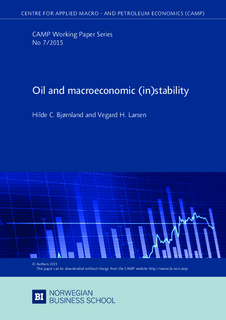| dc.contributor.author | Bjørnland, Hilde C. | |
| dc.contributor.author | Larsen, Vegard H. | |
| dc.date.accessioned | 2015-11-20T10:27:50Z | |
| dc.date.available | 2015-11-20T10:27:50Z | |
| dc.date.issued | 2015 | |
| dc.identifier.issn | 1892-2198 | |
| dc.identifier.uri | http://hdl.handle.net/11250/2364956 | |
| dc.description.abstract | We analyze the role of oil price volatility in reducing U.S. macroeconomic instability. Using a regime-switching structural model we
revisit the timing of the Great Moderation and the sources of changes
in the volatility of macroeconomic variables. We find that smaller or
fewer oil price shocks did not play a major role in explaining the Great
Moderation. Instead oil price shocks are recurrent sources of macroeconomic
fluctuations. The most important factor reducing macroeconomic variability is a decline in the volatility of other structural shocks
(demand and supply). A change to a more responsive monetary policy
regime also played a role. | nb_NO |
| dc.language.iso | eng | nb_NO |
| dc.publisher | BI Norwegian Business School | nb_NO |
| dc.relation.ispartofseries | CAMP Working Paper Series;7/2015 | |
| dc.title | Oil and macroeconomic (in)stability | nb_NO |
| dc.type | Working paper | nb_NO |
| dc.source.pagenumber | 47 | nb_NO |
| dc.source.issue | 7/2015 | nb_NO |
